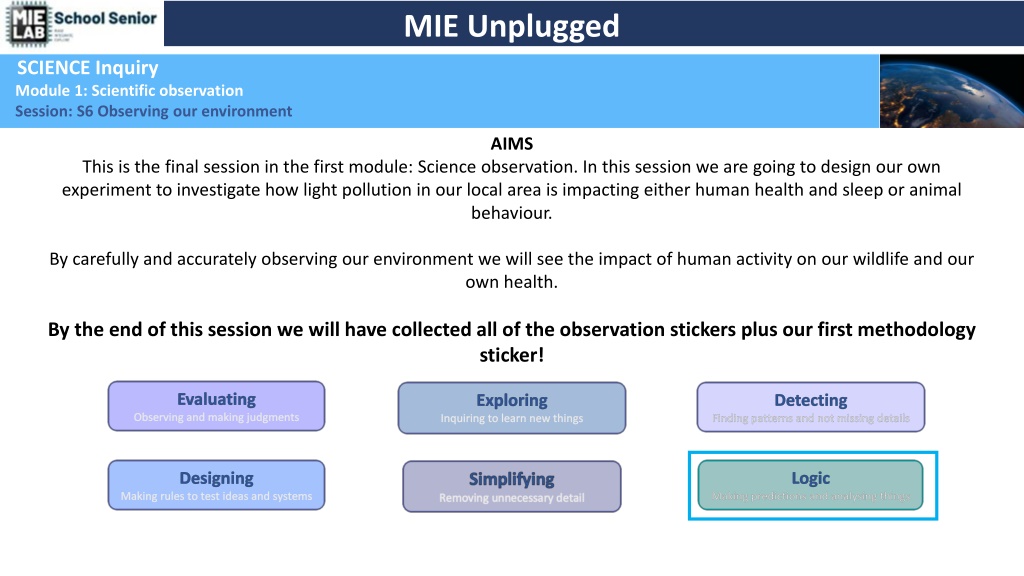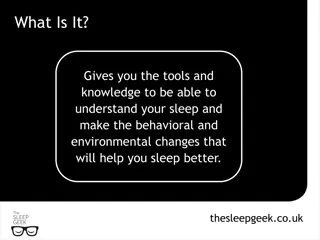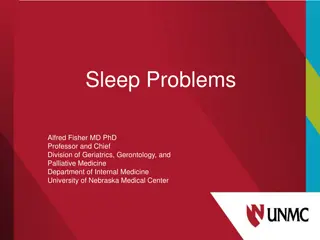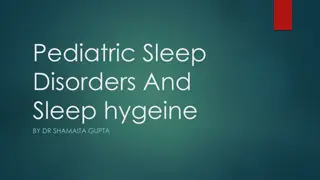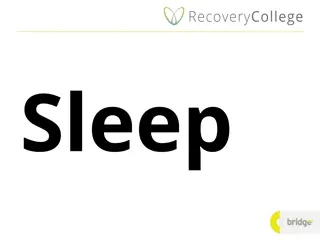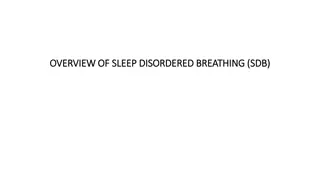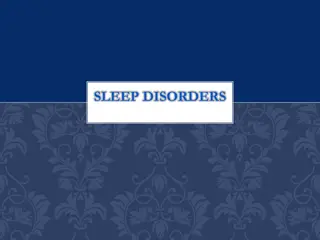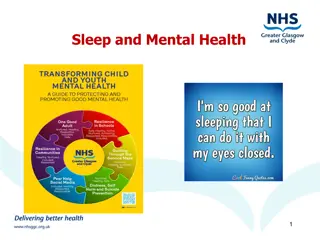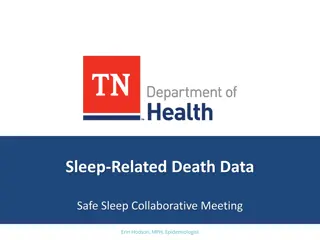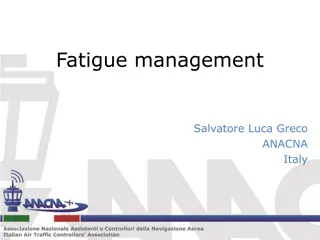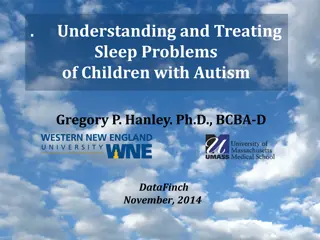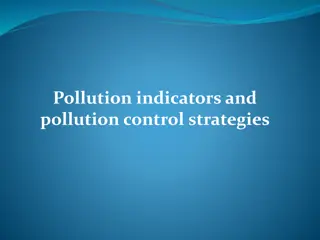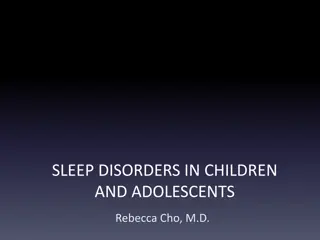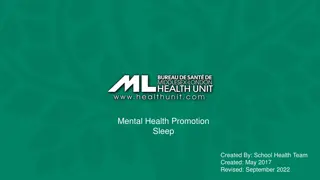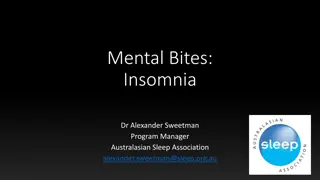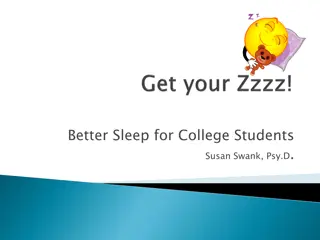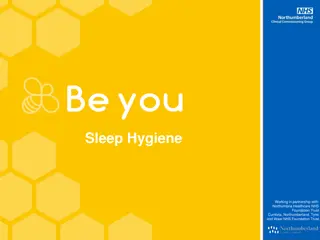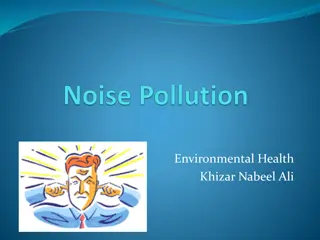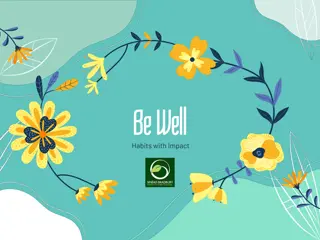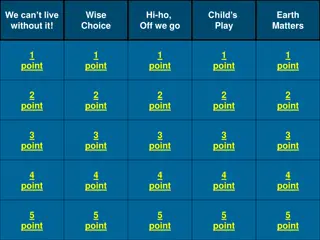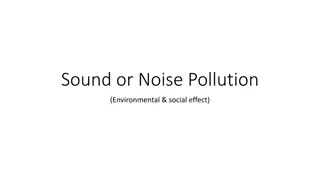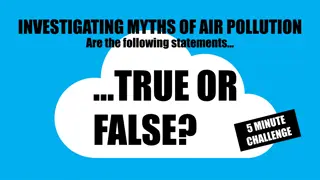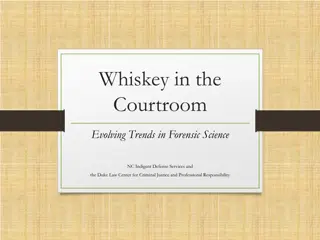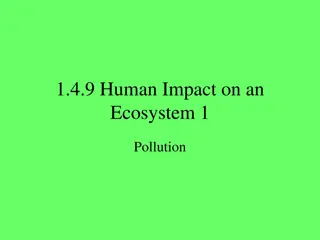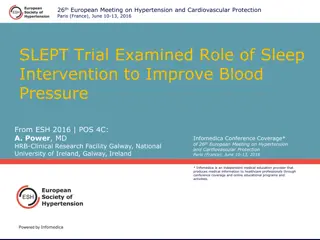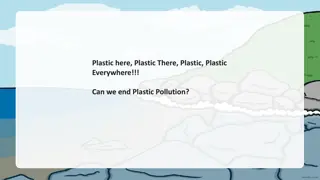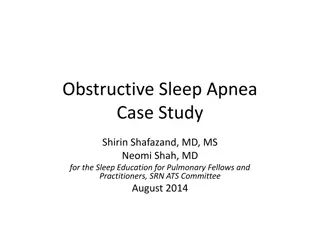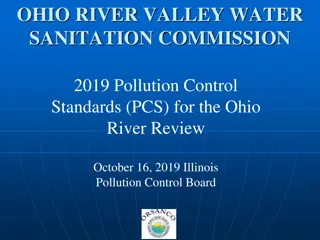Understanding the Impact of Light Pollution on Sleep and Health
Explore how light pollution affects human health, sleep patterns, and wildlife behavior through observation and experimentation. Learn about the benefits of good sleep and factors that can hinder sleep quality. Collect data to understand the importance of addressing light pollution for overall well-being.
Download Presentation

Please find below an Image/Link to download the presentation.
The content on the website is provided AS IS for your information and personal use only. It may not be sold, licensed, or shared on other websites without obtaining consent from the author. Download presentation by click this link. If you encounter any issues during the download, it is possible that the publisher has removed the file from their server.
E N D
Presentation Transcript
MIE Unplugged SCIENCE Inquiry Module 1: Scientific observation Session: S6 Observing our environment AIMS This is the final session in the first module: Science observation. In this session we are going to design our own experiment to investigate how light pollution in our local area is impacting either human health and sleep or animal behaviour. By carefully and accurately observing our environment we will see the impact of human activity on our wildlife and our own health. By the end of this session we will have collected all of the observation stickers plus our first methodology sticker! Evaluating Detecting Exploring Observing and making judgments Finding patterns and not missing details Inquiring to learn new things Designing Logic Making rules to test ideas and systems Making predictions and analysing things
MIE Unplugged SCIENCE Inquiry Module 1: Scientific observation Session: S6 Observing our environment Exploring From the last session we looked in more detail at how light pollution impacts on 2 main areas of concern Inquiring to learn new things Disruption to animal behaviours Human sleep and health
MIE Unplugged SCIENCE Inquiry Module 1: Scientific observation Session: S6 Observing our environment Exploring Inquiring to learn new things Sleep is really important for our physical and mental health As a class brainstorm what you think are the benefits of sleep and then write them down on the board Sleep patterns Now lets see how we did!
MIE Unplugged SCIENCE Inquiry Module 1: Scientific observation Session: S6 Observing our environment Exploring Inquiring to learn new things Sleep is really important for our physical and mental health Good sleep Sleep patterns 1. Helps your body fight illness boosts your immune system 2. Strengthens your heart and cardiovascular system 3. Repairs your body 4. Improves your mood, mental functioning, cognition and productivity 5. Leads to greater exercise performance, more energy, better coordination, faster speed 6. Leads to more social and emotional intelligence 7. Prevents depression and weight gain
MIE Unplugged SCIENCE Inquiry Module 1: Scientific observation Session: S6 Observing our environment Exploring Inquiring to learn new things Sleep is really important for our physical and mental health Data Collection Sheet 1 Good sleep 1. Helps your body fight illness boosts your immune system 2. Strengthens your heart and cardiovascular system 3. Repairs your body 4. Improves your mood, mental functioning, cognition and productivity 5. Leads to greater exercise performance, more energy, better coordination, faster speed. 6. Leads to more social and emotional intelligence 7. Prevents depression and weight gain Sleep benefits Things I do that make it difficult to sleep Benefit 1 Benefit 2 Write these down on your Data Collection Sheet 1 in the Sleep benefits column
MIE Unplugged SCIENCE Inquiry Module 1: Scientific observation Session: S6 Observing our environment How does sleep do all this! Exploring Inquiring to learn new things We have two internal biological mechanisms Circadian rhythms These natural bodily rhythms control the timing of your sleep and cause you to be sleepy at night and wake in the morning without an alarm. Your body s biological clock, which is based on a roughly 24-hour day, controls most circadian rhythms. Circadian rhythms synchronize with environmental cues (light, temperature).
MIE Unplugged SCIENCE Inquiry Module 1: Scientific observation Session: S6 Observing our environment How does sleep do all this! Exploring Inquiring to learn new things We have two internal biological mechanisms Sleep-wake homeostasis keeps track of your need for sleep. The homeostatic sleep drive reminds the body to sleep after a certain time. It tracks how long you are awake. It makes your sleep drive gets stronger every hour you are awake and causes you to sleep longer and more deeply after a period of sleep deprivation.
MIE Unplugged SCIENCE Inquiry Module 1: Scientific observation Session: S6 Observing our environment How does light affect our sleep? Exploring Inquiring to learn new things Perhaps the greatest influence on these two mechanisms is the exposure to light. Specialized cells in the retinas of your eyes process light and tell the brain whether it is day or night and can advance or delay our sleep-wake cycle. Exposure to light can make it difficult to fall asleep and return to sleep when awakened. Can you like of things that you do before bed that make it harder for your brain to produce melatonin and feel sleepy?
MIE Unplugged SCIENCE Inquiry Module 1: Scientific observation Session: S6 Observing our environment How does light affect our sleep? Exploring Inquiring to learn new things Perhaps the greatest influence on these two mechanisms is the exposure to light. Data Collection Sheet 1 Specialized cells in the retinas of your eyes process light and tell the brain whether it is day or night and can advance or delay our sleep-wake cycle. Exposure to light can make it difficult to fall asleep and return to sleep when awakened. Sleep benefits Things I do that make it difficult to sleep Action 1 Action 2 Benefit 1 Benefit 2 Write a list of things that you do before bed that make it harder for your brain to produce melatonin and feel sleepy? Brainstorm with your class and then fill in the Things I do to make it difficult to sleep column
MIE Unplugged SCIENCE Inquiry Module 1: Scientific observation Session: S6 Observing our environment Exploring Inquiring to learn new things Bats and bugs are really important to our survival As a class brainstorm why you think bats and bugs are crucial to our survival and then write them down on the board Bat and bug behaviour Now lets see how we did!
MIE Unplugged SCIENCE Inquiry Module 1: Scientific observation Session: S6 Observing our environment Bats are really important for human survival Exploring Bats and bugs are awesome because! Inquiring to learn new things 1. Bats are the biological pest police they can eat their body weight in bugs in a night, controlling the insect population and saving crops and farmers money. Plant dispersal many plants rely on bats and bugs to spread their seeds. Without bats we wouldn t have these fruits or chocolate! Bats aid in restoring forests as they are one of few animals that drop seeds outside of forest areas, bats have been called farmers of the tropics . More than 50% of the old world rainforest is maintained by bats. Plant pollination - Nectar-eating bats are crucial pollinators for over 500 plant species and bugs as well as birds do the rest! Fertilizer production guano is some of the richest fertilizer in the world. Bat saliva may soon be used to treat human cardiac patients. Bat and bug behaviour 2. 3. 4. 5. 6.
MIE Unplugged SCIENCE Inquiry Module 1: Scientific observation Session: S6 Observing our environment Bats are really important for human survival Exploring Bats and bugs are awesome because! Inquiring to learn new things 1. Bats are the biological pest police they can eat their body weight in bugs in a night, controlling the insect population and saving crops and farmers money. Plant dispersal many plants rely on bats and bugs to spread their seeds. Without bats we wouldn t have these fruits or chocolate! Bats aid in restoring forests as they are one of few animals that drop seeds outside of forest areas, bats have been called farmers of the tropics . More than 50% of the old world rainforest is maintained by bats. Plant pollination - Nectar-eating bats are crucial pollinators for over 500 plant species and bugs as well as birds do the rest! Fertilizer production guano is some of the richest fertilizer in the world. Bat saliva may soon be used to treat human cardiac patients. Data Collection Sheet 1 2. Effects of light pollution on bats and bugs Crucial role of bats and bugs 3. 4. Role 1 Role 2 5. 6. Write these down on your Data Collection Sheet 1 in the Crucial role of Bats column
MIE Unplugged SCIENCE Inquiry Module 1: Scientific observation Session: S6 Observing our environment Exploring How does light pollution affect bat and bug bahaviour? Inquiring to learn new things Many insect species are attracted to artificial light, which makes them easier for bats to foraging. In fact, areas with bright lights, such as over car yards or tennis courts, can be a good place to watch bats and bugs during warm weather. However, many species of bats are adversely affected by brightly lit areas at night, which cause them to change their migration or feeding routes. This puts them at a much greater risk of death from predation for example by owls or cats, road kill, flying into buildings or sheer exhaustion from being disoriented.
MIE Unplugged SCIENCE Inquiry Module 1: Scientific observation Session: S6 Observing our environment Exploring Inquiring to learn new things How does light pollution affect bat behaviour? Data Collection Sheet 1 Brainstorm how light sources may affect bat behaviour in your local area and then write these down on your Data Collection Sheet 1 in the Effects of light pollution on bats and bugs column Effects of light pollution on bats and bugs Crucial role of Bats and bugs Behaviour change 1 Behaviour change 2 Role 1 Role 2
MIE Unplugged SCIENCE Inquiry Module 1: Scientific observation Session: S6 Observing our environment Evaluating We are now going to split into 2 groups Observing and making judgments Half of you are going to observe sleep patterns and the other half and going to observe the behaviour of bats Designing Making rules to test ideas and systems Bat and bug behaviour Sleep patterns
MIE Unplugged SCIENCE Inquiry Module 1: Scientific observation Session: S6 Observing our environment Evaluating Observing and making judgments Team Sleep patterns Designing You are going to design an experiment to see the affects of light pollution on sleep Making rules to test ideas and systems You will each need to measure: 1. Your sleep quality over one week 2. The darkness of your room just before bedtime
MIE Unplugged SCIENCE Inquiry Module 1: Scientific observation Session: S6 Observing our environment Evaluating Observing and making judgments Team Sleep patterns Designing You are going to design an experiment to see the affects of light pollution on sleep Making rules to test ideas and systems You will each need to think about: 1. What are you going to measure to determine sleep quality 2. What scale are you going to use to measure darkness
MIE Unplugged SCIENCE Inquiry Module 1: Scientific observation Session: S6 Observing our environment Evaluating Observing and making judgments Team Sleep patterns Designing You are going to design an experiment to see the affects of light pollution on sleep. Making rules to test ideas and systems For each night of the week fill in the Data Collection Sheet 2 Sleep Patterns. At the end of the week you will need to bring all your data together and analyse it as a team.
MIE Unplugged SCIENCE Inquiry Module 1: Scientific observation Session: S6 Observing our environment Evaluating Team Bat behaviour Observing and making judgments You are going to design an experiment to see the affects of light pollution on bat and bug behaviour. Designing Making rules to test ideas and systems You will each need to measure: 1. How many bats and bugs you can see in your back yard at night 2. The darkness of your back yard as you are counting bats and bugs
MIE Unplugged SCIENCE Inquiry Module 1: Scientific observation Session: S6 Observing our environment Evaluating Team Bat behaviour Observing and making judgments You are going to design an experiment to see the affects of light pollution on bat and bug behaviour. Designing Making rules to test ideas and systems You will each need to think about: 1. How are you going to count them 2. What scale are you going to use to measure darkness
MIE Unplugged SCIENCE Inquiry Module 1: Scientific observation Session: S6 Observing our environment Evaluating Team Bat behaviour Observing and making judgments You are going to design an experiment to see the affects of light pollution on bat and bug behaviour. Designing Making rules to test ideas and systems For each night of the week fill in the Data Collection Sheet 2 Bat and bug behaviour. At the end of the week you will need to bring all your data together and analyse it as a team.
MIE Unplugged SCIENCE Inquiry Module 1: Scientific observation Session: S6 Observing our environment Evaluating Team Sleep Patterns Observing and making judgments Analysing your data Detecting Finding patterns and not missing details Before we begin you should think about what you expect to see. Logic Making predictions and analysing things What do you think the data will tell you? This is known as a hypothesis. What do you hypothesise that the data will tell us? Do you hypothesise that sleep quality will improve with darkness? Discuss with your class what you expect to see, what is your hypothesis?
MIE Unplugged SCIENCE Inquiry Module 1: Scientific observation Session: S6 Observing our environment Evaluating Team Sleep Patterns Observing and making judgments Analysing your data Detecting Finding patterns and not missing details Bring all your data together and as a team, plot it on the graph paper provided by your teacher. Logic Making predictions and analysing things To do this you will need to: 10 x x 1. Label the x axis light pollution x 2. Label the y axis sleep quality Sleep quality x 3. Find the highest and lowest value of each and add the x 6 x scale to the axes x x 4. For each days entry find the light pollution value on the x x axis and the corresponding sleep quality values on the y x axis and mark with an X 1 5. Do this for everyone s data 5 1 10 Light pollution
MIE Unplugged SCIENCE Inquiry Module 1: Scientific observation Session: S6 Observing our environment Evaluating Team Bat Behaviour Observing and making judgments Analysing your data Detecting Finding patterns and not missing details Before we begin you should think about what you expect to see. Logic Making predictions and analysing things What do you think the data will tell you? This is known as a hypothesis. What do you hypothesise that the data will tell us? Discuss with your class what you expect to see, what is your hypothesis?
MIE Unplugged SCIENCE Inquiry Module 1: Scientific observation Session: S6 Observing our environment Evaluating Team Bat Behaviour Observing and making judgments Analysing your data Detecting Finding patterns and not missing details Bring all your data together and as a team, plot it on the graph paper provided by your teacher. Logic Making predictions and analysing things 10 To do this you will need to: x x 1. Label the x axis light pollution Number of Bats x 2. Label the y axis Number of Bats x x 6 3. Find the highest and lowest value of each and add the scale x x to the axes x x 4. For each days entry find the light pollution value on the x x axis and the corresponding bat number values on the y axis and mark with an X 1 5 1 10 5. Do this for everyone s data Light pollution
MIE Unplugged SCIENCE Inquiry Module 1: Scientific observation Session: S6 Observing our environment Evaluating Results and Discussion Observing and making judgments Analysing your data Detecting Finding patterns and not missing details Now draw a line through your points that best fits your data known as a trend line. Logic Making predictions and analysing things 10 In this example the trend line shows us that as light pollution increases sleep quality goes down. x x x Sleep quality x x x x x x x 1 1 10 Light pollution
MIE Unplugged SCIENCE Inquiry Module 1: Scientific observation Session: S6 Observing our environment Evaluating Results and Discussion Observing and making judgments Analysing your data Detecting Finding patterns and not missing details Now draw a line through your points that best fits your data known as a trend line. Logic Making predictions and analysing things 10 In this example the trend line shows us that as light pollution increases sleep quality goes up. x x Sleep quality x x x x x x x x 1 1 10 Light pollution
MIE Unplugged SCIENCE Inquiry Module 1: Scientific observation Session: S6 Observing our environment Evaluating Results and Discussion Observing and making judgments Analysing your data Detecting Finding patterns and not missing details Now draw a line through your points that best fits your data known as a trend line. Logic Making predictions and analysing things 10 In this example the trend line shows us that there is no relationship between light pollution and sleep quality. One does not affect the other. x x x Sleep quality x x x x x x x 1 1 10 Light pollution
MIE Unplugged SCIENCE Inquiry Module 1: Scientific observation Session: S6 Observing our environment Evaluating Results and Discussion Observing and making judgments Analysing your data Detecting Finding patterns and not missing details Now draw a line through your points that best fits your data. This is known as a trend line. Logic Making predictions and analysing things 10 You have now mapped the relationship between light pollution and sleep quality or bat behaviour in your local area!!! x x x Sleep quality x x What does your trend line say about your data? x x x Does this match your hypothesis? Is this what you were expecting? x x 1 1 10 Light pollution
MIE Unplugged SCIENCE Inquiry Module 1: Scientific observation Session: S6 Observing our environment Evaluating Results and Discussion Observing and making judgments Sources of error and improvements! Detecting Finding patterns and not missing details Getting everyone to collect a small amount of data and then putting it all together is a great way to investigate a big problem. Logic Making predictions and analysing things But can you think of any problems with this approach? Did you all follow the same method? Was one method a better approach than others, or should you have collected more variables to define sleep quality, and bat and bug behaviour? Do we need more data to better map our area? Do we need more people living in different environments with different levels of light pollution to tell the true affects of light pollution? What would you do next time?
MIE Unplugged SCIENCE Inquiry Module 1: Scientific observation Session: S6 Observing our environment Achievements! By carrying out this Science Observation Module you have learnt to Explore your environment, Evaluate your observations to Detect patterns, and then Design and Simplify measures to investigate further! You have then used all these skills together to use Logic to make predictions and analysis your observations! This is a great start! We now have the fundamental skills to perform any scientific observation. Evaluating Detecting Exploring Observing and making judgments Finding patterns and not missing details Inquiring to learn new things Designing Logic Making rules to test ideas and systems Making predictions and analysing things
MIE Unplugged SCIENCE Inquiry Module 1: Scientific observation Session: S6 Observing our environment Achievements! By using these skills we now have a map of light pollution and an idea of how light pollution affects our sleep and bat behaviour in our local area. Evaluating Detecting Exploring Observing and making judgments Finding patterns and not missing details Inquiring to learn new things Designing Logic Making rules to test ideas and systems Making predictions and analysing things
MIE Unplugged SCIENCE Inquiry Module 1: Scientific observation Session: S6 Observing our environment Achievements! In the next module: Science methodology we are going to improve on our method and add to our dataset. Learn how to define a method and how experts measure sleep and bat behaviour. We will then run these improved experiments again and your data will then contribute to the citizen science projects that are running in Queensland! Evaluating Detecting Exploring Observing and making judgments Finding patterns and not missing details Inquiring to learn new things Designing Logic Making rules to test ideas and systems Making predictions and analysing things
MIE Unplugged SCIENCE Inquiry Module 1: Scientific observation Session: S6 Observing our environment Exploring Inquiring to learn new things Now we are going to hear from a member of the local community about how human activity has impacted the local wildlife.
